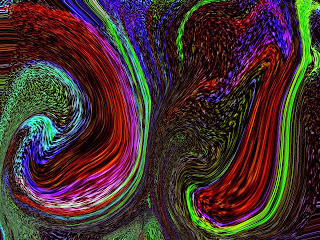Pearl Zhu's Blog, page 96
June 16, 2025
Narratives
Narratives help individuals construct their identities by allowing them to organize their experiences into coherent stories.
 Narratives are central to the human experience, serving as a mirror to human nature, society, and the complexities of life. Narratives, particularly myths, profoundly reflect cultural values by embodying a society's self-image, explaining customs, and validating life itself. They explore a people's identity through their characteristics and details.
Narratives are central to the human experience, serving as a mirror to human nature, society, and the complexities of life. Narratives, particularly myths, profoundly reflect cultural values by embodying a society's self-image, explaining customs, and validating life itself. They explore a people's identity through their characteristics and details.Storytelling, a sensory union of image and idea, recreates the past in terms of the present. Storytellers use realistic images to describe the present and fantasy images to evoke the culture's experience of the past. This process involves masking the past, making it emotionally accessible, and collapsing time so that history becomes a means of reliving an obscure past. The blending of past and present generates ideas and shapes contemporary life, emphasizing interdependence and the consequences of forsaking obligations.
Historical events significantly influence stories by providing material and context that shape narratives. History, stemming from archetypal human narrative activity, shares ancestry with myth, legend, and epic poetry, diverging in its claim to truth based on real events and people.
Here’s how historical events influence stories:
-Source Material: Historical events offer a foundation for stories, with writers drawing inspiration from wars, disasters, and social changes.
-Authenticity: Stories set in historical contexts gain depth through accurate depictions of past events, cultures, and societal norms.
-Themes and Messages: Historical events often carry profound themes such as survival, justice, and the human spirit, which writers explore in their narratives.
-Relevance: By reflecting on historical events, stories can offer insights into contemporary issues, helping readers understand the present in light of the past.
-Cultural Impact: Major historical events change culture, and these events need to be tied to the ancient images of the culture.
-Personalization: Historical events are recorded in terms of human immediacies, not scientific or demographic abstractions, and this approach is essentially novelistic.
-Historical narratives address origins and explain what is in terms of its genesis, not statically, but in the process of becoming. They invite an explanation of what is in terms of its genesis, not statically, but in the process of becoming.
Narratives help individuals construct their identities by allowing them to organize their experiences into coherent stories. This process aids in understanding one's place in the world and personal growth. Through these mechanisms, narratives serve as a means of reliving the past, understanding the present, and reinforcing the essential core of a society's beliefs.
Follow us at: @Pearl_ZhuJune 15, 2025
Innovativeness
Innovation is the artwork we weave through creative threads. Each thread may represent a different disciplinary perspective, cultural viewpoint, or philosophical approach, bringing richness and depth to our understanding to foster innovation.
 Imagine a vibrant, sprawling tapestry, woven together from an array of colorful threads. The creative atmosphere can be viewed from different perspectives, including individual characteristics and the interaction between the individual and their environment. Organizational culture also plays a significant role in harnessing innovation and catalyzing change.
Imagine a vibrant, sprawling tapestry, woven together from an array of colorful threads. The creative atmosphere can be viewed from different perspectives, including individual characteristics and the interaction between the individual and their environment. Organizational culture also plays a significant role in harnessing innovation and catalyzing change.Individual Perspectives: Creative individuals often exhibit autonomy, independence, and nonconformity in their thoughts and actions. They also display curiosity, a need to seek novelty, and an ability to pose unique questions. Creative thinking involves divergent thinking, which leads to new information and previously undiscovered solutions. This includes fluency, flexibility, and originality. Intrinsic motivation, arising from intense autonomous interest in the work, is a key factor. The capacity to experience "flow," defined as total involvement in an activity, is also characteristic of creative people.
Systems View: The "systems" approach considers the relationship between the creative individual and the larger world. This view comprises the creative individual, with their talents, experiences, and aspirations; the domain, which is the class of knowledge or activity; the field, represented by opinion leaders who recognize and reward ideas.
Organizational Culture: Organizational culture includes beliefs, assumptions, values, norms, artifacts, symbols, actions, and language patterns shared by members. Understanding organizational culture is important because it affects organizational growth & development, productivity, and learning at all levels.
Innovation is the artwork we weave through creative threads. Each thread may represent a different disciplinary perspective, cultural viewpoint, or philosophical approach, bringing richness and depth to our understanding to foster innovation.
People Growth via Information Analysis
As industries evolve due to technological advancements, talent development helps bridge skill gaps by preparing employees for roles that may not yet exist.
 In a rapidly changing environment, people have to continue learning and growing, shaping their mindset and sharpening their skillset for improving professional competency.
In a rapidly changing environment, people have to continue learning and growing, shaping their mindset and sharpening their skillset for improving professional competency. A data-driven strategy for talent development relies on collecting, processing, and analyzing data to inform decisions about employee growth and skill enhancement. This approach ensures that talent development initiatives are aligned with organizational goals and individual needs.
Descriptive Data Analysis: Descriptive data analysis can play a crucial role in talent management by helping organizations understand and optimize their workforce. It involves using statistical techniques to summarize and interpret data related to employee performance, engagement, and other relevant metrics. Using statistics to summarize data and understand its broad qualities. Looking for insights into the data through distributions, central tendency, and variability. Visualizations like histograms and stem-and-leaf plots can be leveraged.
Predictive Analysis: Predictive analysis uses machine learning, regression analysis, and classification techniques to identify trends and relationships among variables, enabling predictions about future talent needs. Data mining, including cluster analysis and anomaly detection, can uncover patterns and unusual instances in large datasets. Predictive analysis in talent development involves using data-driven techniques to identify and nurture individual talents effectively. Gather data on employee performance, including sales numbers, project completion rates, and feedback scores. Use assessments to evaluate current skills and identify areas for improvement.
Prescriptive Analysis: Prescriptive analysis goes beyond predictive analysis by recommending specific actions based on data insights. In the context of talent growth, it involves using data to guide organizations in developing their employees effectively. Evaluate the effectiveness of existing training programs using data analytics to determine which programs yield the best results. Recommend the optimal allocation of resources for training based on the predicted impact on talent growth.
Global talent development is evolving rapidly, driven by changes in technology, workforce demographics, and organizational needs. As industries evolve due to technological advancements, talent development helps bridge skill gaps by preparing employees for roles that may not yet exist.
Follow us at: @Pearl_ZhuLegal Innovators California 2025
It's a professional conference with a great intention to connect the dots between different industries, facilitating connections between legal professionals and tech innovators, and fostering potential collaborations.
 It's already mid-June, but the weather in San Francisco is still a bit cold, very windy last week. I saw pedestrians wearing all sorts of clothing from winter jackets to T-shirts. But when the Sun comes up, it's warm and delightful. People across the world came here for different conferences or tourism.
It's already mid-June, but the weather in San Francisco is still a bit cold, very windy last week. I saw pedestrians wearing all sorts of clothing from winter jackets to T-shirts. But when the Sun comes up, it's warm and delightful. People across the world came here for different conferences or tourism. I headed to the city center area, participating in an informative conference: Legal Innovators California 2025, which brought together legal professionals, technologists, and thought leaders to explore the intersection of law and technology. The staff at the conference were very friendly, helping me finish the registration smoothly. So I could learn and think about lots of problems from different perspectives. The event focused on innovative practices, emerging technologies, and strategies to enhance legal services.
Expo: In the exhibition hall, some IT software vendors and legal firms presented their solutions to the audience. Their AI-enabled solutions can help legal industries improve automation, transparency, process efficiency, and cost savings.
Conference: Inside the conference hall, I participated in a couple of presentations focusing on brainstorming IT-enabled solutions, particularly for the legal industry. I like one of the presenters' comments: The reasons folks come to these events because we try to close our own blind spots, figure out how to solve problems from different angles.
Keynote & Presentation: Those presenters focused on brainstorming the future of legal tech, emphasizing the importance of embracing change in the legal profession. They also discussed the ethical implications of AI in legal decision-making, urging the audience to consider fairness and transparency. The topics include:
-Where Are We Heading With Legal AI?
-AI That Grows Profits and Powers Strategic Decisions
-The Future of Legal Work
-Extract Legal/Compliance Insights
-Meet your New Collaborative Work Space
-Unlocking Hidden Value: How Law Firms Can Turn Transaction Data into Competitive Intelligence
...
Panel Discussion: These discussions focused on practical strategies for integrating technology into law firms. shared their firms' best practices for navigating the complexities of transforming legal workflows, understanding the importance of data protection, data privacy, and compliance.
-Driving Profitability With GenAI
-Disputes in the Age of AI
-AI and The New Normal for Innovation Teams
-The Advent of GenAI in Contracting
-Transforming Legal Workflows
-Doing More In-House With Generative AI
-Building the Perfect In-House Tech Stack
...
Pitch: Emerging legal tech startups presented their innovative solutions, ranging from AI-driven tools for legal clients to automated contract analysis platforms.
-How to correctly dissolve your clients’ entities
-Easy to use, powerful, and cost-efficient: Moving beyond generic, one-size-fits-all contract AI solutions through purpose-built AI Agents
-From Months to Minutes: Scaling Document Review 100x with AI Drive Agents
The Legal Innovators California 2025 Conference showcased the dynamic landscape of legal technology and its potential to transform the legal profession. Experts shared insights on how technology is reshaping client interactions and service delivery. It's a professional conference with a great intention to connect the dots between different industries, facilitating connections between legal professionals and tech innovators, and fostering potential collaborations. Participants left with valuable insights, new connections, and inspiration to drive innovation in their own practices.
Innovate Governance
By recognizing the interconnected nature of systems, organizations can harness the collective strengths of their members to navigate complex challenges effectively.
 The context for corporate governance includes a wide range of circumstances and capabilities that are subject to constant organizational variability.
The context for corporate governance includes a wide range of circumstances and capabilities that are subject to constant organizational variability. Holographic governance is an idea that can be understood in various contexts, often relating to how organizations or societies manage and structure themselves in a non-linear, interconnected way. Below are key aspects of holographic governance:
Holographic Structure: Similar to a hologram, where each part contains the whole image, holographic governance suggests that each unit within an organization (or society) reflects and contains the values, goals, and functions of the entire system.
Decentralization: Power and decision-making are distributed throughout the organization rather than concentrated at the top. This allows for more agile and responsive governance.
Key Principles of holographic governance:
-Interconnectedness: Every part of the system is interrelated. Changes in one area can affect the whole, promoting a holistic approach to governance.
-Transparency and Inclusivity: Emphasize open communication and participation from all stakeholders, fostering a culture of trust and collaboration.
-Agility: The structure allows for flexibility and adaptability, enabling organizations to respond quickly to changes in the environment.
Applications of holographic governance:
Organizational Management: Used in businesses to create more collaborative environments where teams operate semi-autonomously, empowering employees to take initiative.
Community Governance: Applied in local governance models that encourage citizen participation and grassroots decision-making, enhancing community engagement.
Advantages of holographic governance:
-Enhance Innovation: By leveraging diverse perspectives and ideas, organizations can foster greater creativity and innovation.
-Improve Responsiveness: Decentralized decision-making enables faster responses to challenges and opportunities.
-Stronger Engagement: Greater involvement from stakeholders leads to increased commitment and satisfaction.
Challenges of Governance
-Coordination: Ensuring effective communication and coordination among decentralized units can be complex.
-Consistency: Maintaining a unified vision and values across the organization may be challenging without strong leadership.
-Resistance to Change: Shifting from traditional governance models to holographic structures may face resistance from those accustomed to hierarchical systems.
Holographic governance offers a framework for more dynamic and adaptive governance structures, promoting inclusivity and responsiveness. By recognizing the interconnected nature of systems, organizations can harness the collective strengths of their members to navigate complex challenges effectively.
SF’s NB Festival 2025
Attendees enjoyed a rich array of artistic expressions, culinary experiences, and lively entertainment, making it a memorable event in San Francisco.
 There are so many great conferences and events going on in San Francisco this year. The North Beach Festival 2025 celebrated the vibrant culture, art, and culinary delights of San Francisco’s historic North Beach neighborhood. This annual event featured a mix of live entertainment, local vendors, and community activities.
There are so many great conferences and events going on in San Francisco this year. The North Beach Festival 2025 celebrated the vibrant culture, art, and culinary delights of San Francisco’s historic North Beach neighborhood. This annual event featured a mix of live entertainment, local vendors, and community activities.Art, Fashion, and Craft Vendors: I walked through the streets around the area at noon time, hundreds of colorful booths already set up; as local artisans showcased unique handmade crafts, artwork, jewelry, food, and drinks, emphasizing the creativity of the community. Most of the crafts and artworks are colorful and uniquely designed, fitting the taste of diversified audiences.
Live Music and Performances: A diverse lineup of musicians and performers entertained attendees with live music, dance, and theatrical performances throughout the festival. The audience also took the music's rhyme to dance around.
Culinary Delights: Local restaurants and food vendors offered a variety of international cuisines, including classic dishes, gourmet treats, and specialty beverages. People seemingly enjoyed the food, relaxing or chatting in nearby Cafes.
The North Beach Festival 2025 was a vibrant celebration of culture, creativity, and community spirit. The event fostered a strong sense of community, encouraging local residents and visitors to connect and celebrate the unique character of the city, creating a cultural atmosphere where people all had some fun. Attendees enjoyed a rich array of artistic expressions, culinary experiences, and lively entertainment, making it a memorable event in San Francisco.
Parents' Love
Every word of encouragement, every gentle cheer. Together we’ll stand, for each other’s sake. In the light of our care, we celebrate the holiday.
 Another Father's Day is coming,
Another Father's Day is coming,reminding us of the family's love.
No matter the distance,
we care about each other deeply.
With the change of the four seasons,
we spread to different places in the world.
regardless of where we are,
what we did experience,
parents' affection,
means we bring each other,
some warm feels and love.
Every word of encouragement,
every gentle cheer,
Together we’ll stand,
for each other’s sake.
In the light of our care,
we celebrate the holiday.
Follow us at: @Pearl_ZhuStrategic Communication
These attributes collectively enhance the effectiveness of strategic communication in achieving organizational goals and fostering strong relationships with stakeholders.
 Communication is the bridge between minds and words. Strategic and effective communication is like the thread to connect all important business gems, for building a trustworthy relationship, enforcing collaboration, and improving digital readiness.
Communication is the bridge between minds and words. Strategic and effective communication is like the thread to connect all important business gems, for building a trustworthy relationship, enforcing collaboration, and improving digital readiness. Here are the attributes of strategic communication.
Purposeful: Every message is crafted with a specific goal in mind, aiming to inform, persuade, or engage the audience.
Audience-Centric: Understanding the target audience is crucial. Communication strategies are tailored to meet the needs, preferences, and expectations of the audience.
Consistent: Consistency in messaging across all channels helps build trust and credibility. It reinforces the core message and brand identity.
Clear and Concise: Effective communication is straightforward and easy to understand. Avoiding jargon and complexity enhances clarity.
Feedback-Oriented: Encouraging and incorporating feedback is essential. It allows for adjustments and improvements based on audience reactions.
Agile: Strategies must be flexible and responsive to changing circumstances, trends, or audience dynamics. This agility ensures relevance.
Integrated: Strategic communication often combines various channels and tactics (social media, public relations, advertising) to create a cohesive approach.
Research-Based: Informed by data and analysis, effective communication strategies rely on research to understand the landscape, audience behavior, and potential impact.
Ethical: Upholding ethical standards is vital. Transparency, honesty, and integrity foster trust and establish a positive reputation.
Measurable: Success is assessed through metrics and evaluation methods. This helps gauge effectiveness and informs future strategies.
These attributes collectively enhance the effectiveness of strategic communication in achieving organizational goals and fostering strong relationships with stakeholders.
International Tea Exhibition Beijing 2025
The Beijing Tea Exhibition 2025 was a vibrant celebration of tea culture, uniting a diverse community of tea enthusiasts and industry professionals.
 In early Spring, I was in Beijing to participate in a few informative conferences in the city center. On one weekend, I also headed toward the Tea Exhibition located in the Agriculture Exhibition Center.
In early Spring, I was in Beijing to participate in a few informative conferences in the city center. On one weekend, I also headed toward the Tea Exhibition located in the Agriculture Exhibition Center. The event brought together tea enthusiasts, producers, and industry professionals to celebrate the rich culture and heritage of tea. The event showcased a wide variety of teas, tea-related products, and services in the industry.
Key Highlights of the Tea Exhibition:
Diverse Tea Varieties: Exhibitors presented a vast selection of teas, including green, black, oolong, and herbal teas from various regions of China and around the world. The staff in the different booths were very friendly; they were prepared with tea samples and had guests tasting their small cups of tea. The prices of tea vary; some of them were actually very expensive.
Tea Classification by Manufacturing Process: The most important classification is based on the manufacturing process, which results in three main categories:
Fermented (black) tea: The most common type, often made from Assam or hybrid plants. The infused leaf is bright red or copper-colored, and the liquor is bright red and slightly astringent with a characteristic aroma.
Unfermented (green) tea: It's usually produced from the China plant and grown mostly in Japan, China, and to some extent, Malaysia and Indonesia. The infused leaf is green, and the liquor is mild, pale green or lemon-yellow, and slightly bitter.
Semifermented (oolong) tea: It's produced mostly in southern China and Taiwan from a special variety of the China plant. The liquor is pale or yellow, like green tea, and has a unique malty or smoky flavor.
Workshops and Tastings: Attendees participated in hands-on workshops that focused on tea brewing techniques, tasting sessions, and the art of tea pairing with food.
Cultural Performances:
Traditional performances, including tea ceremonies, traditional music, and cultural dances, highlighted the historical significance of tea in Asian culture.
The Beijing Tea Exhibition 2025 was a vibrant celebration of tea culture, uniting a diverse community of tea enthusiasts and industry professionals. Some exhibitors emphasized sustainable practices in tea cultivation and production, showcasing organic and ethically sourced teas. Participants left with a deeper appreciation for tea's freshness and cultural heritage, as well as valuable connections within the industry.
Follow us at: @Pearl_ZhuRhyme of Reason
In the echoes of time, our efforts to change never stop; in the hyperdiversified globe, we reimagine a holistic world.
 In a world so vast,
In a world so vast,We wandered around,
under the stars at night.
Nature's sound echoed through -
the valley deep,
calling us like a gentle breeze.
Oh, when the days were free,
We are passionate inside,
Memories linger into-
threads of holistic experiences.
In the waves of changes,
where we constantly discover ourselves.
Rhyme of Reason,
We wrote our stories on-
the flow of days and nights,
Every moment cherished,
every reason, a rhyme.
Through the storms and sunshine,
we stood so strong,
Step by step, we make them solid...
Rhyme of Reason,
Though the years have flown and the seasons shift,
those difficult moments make the journey so ardent.
Every frown, every tear,
Drives us to shape a better world.
In the tapestry of deep understanding,
can we bridge the gap with world of differences.
So here’s to the vision we co-shape together.
To the long, long road that brought us together.
In the echoes of time,
our efforts to change never stop;
in the hyperdiversified globe,
we reimagine a holistic world.



